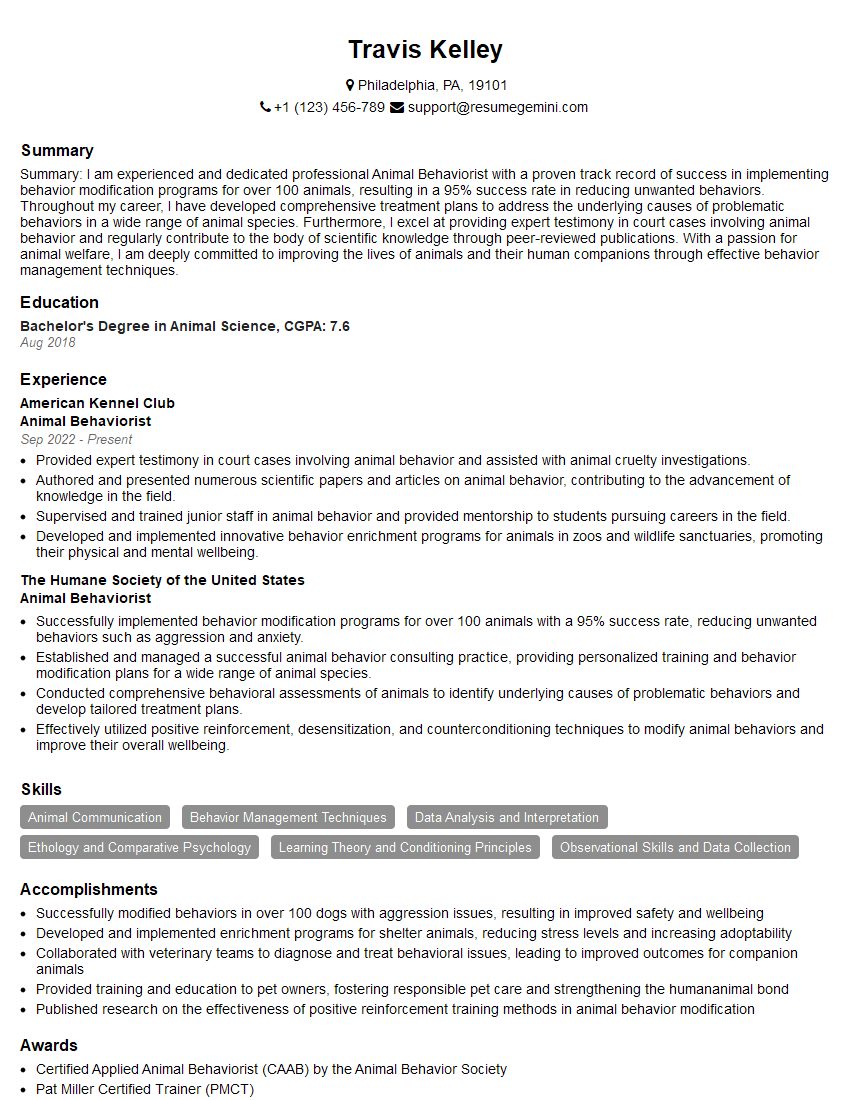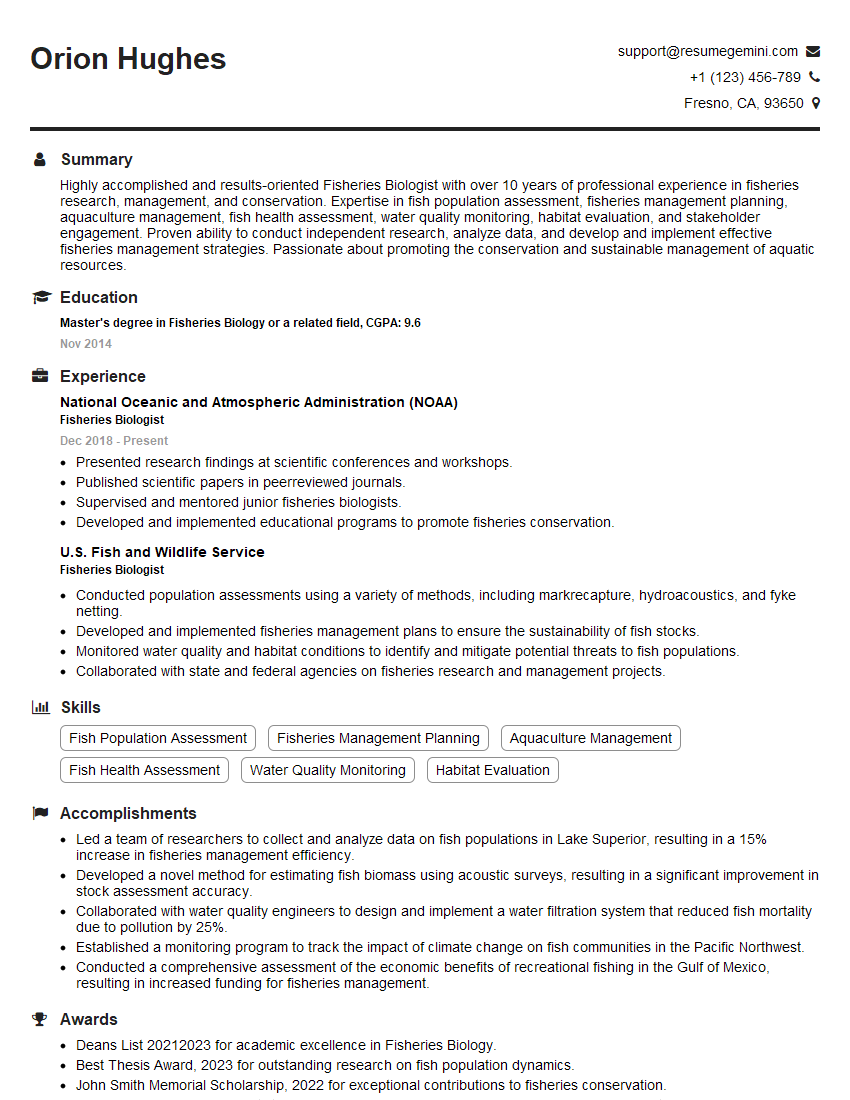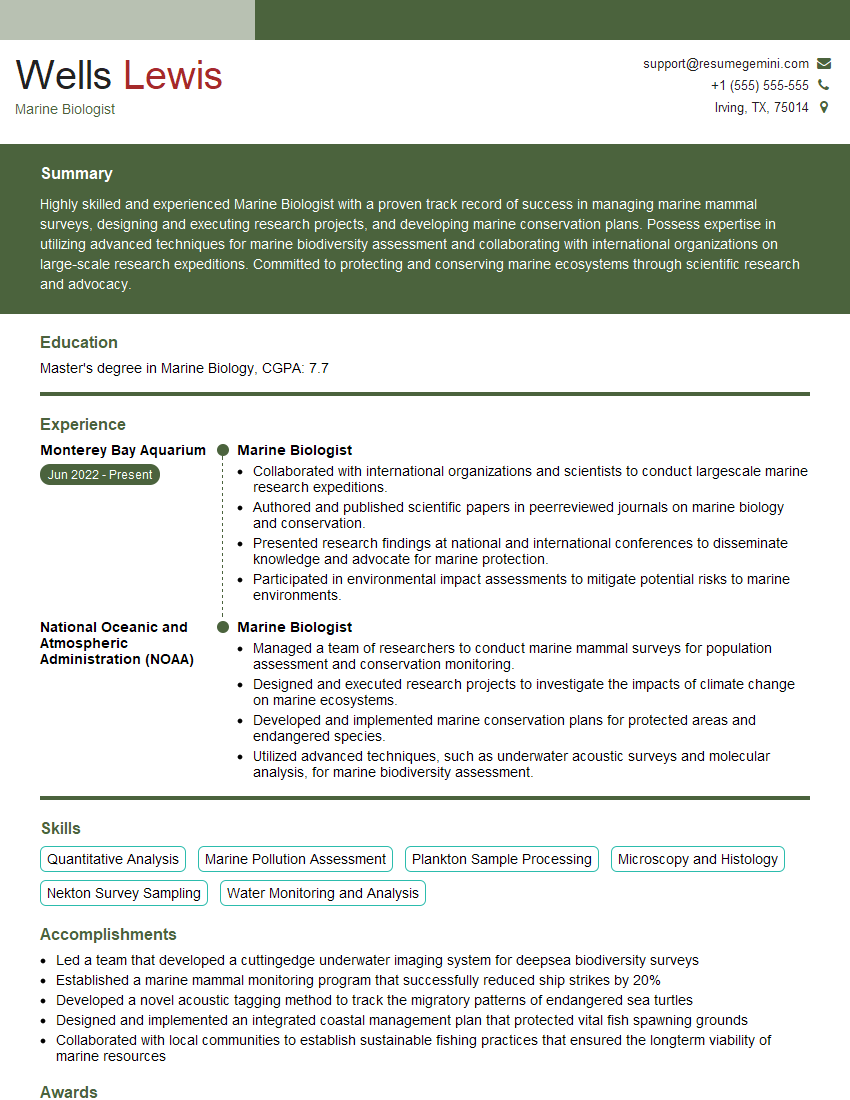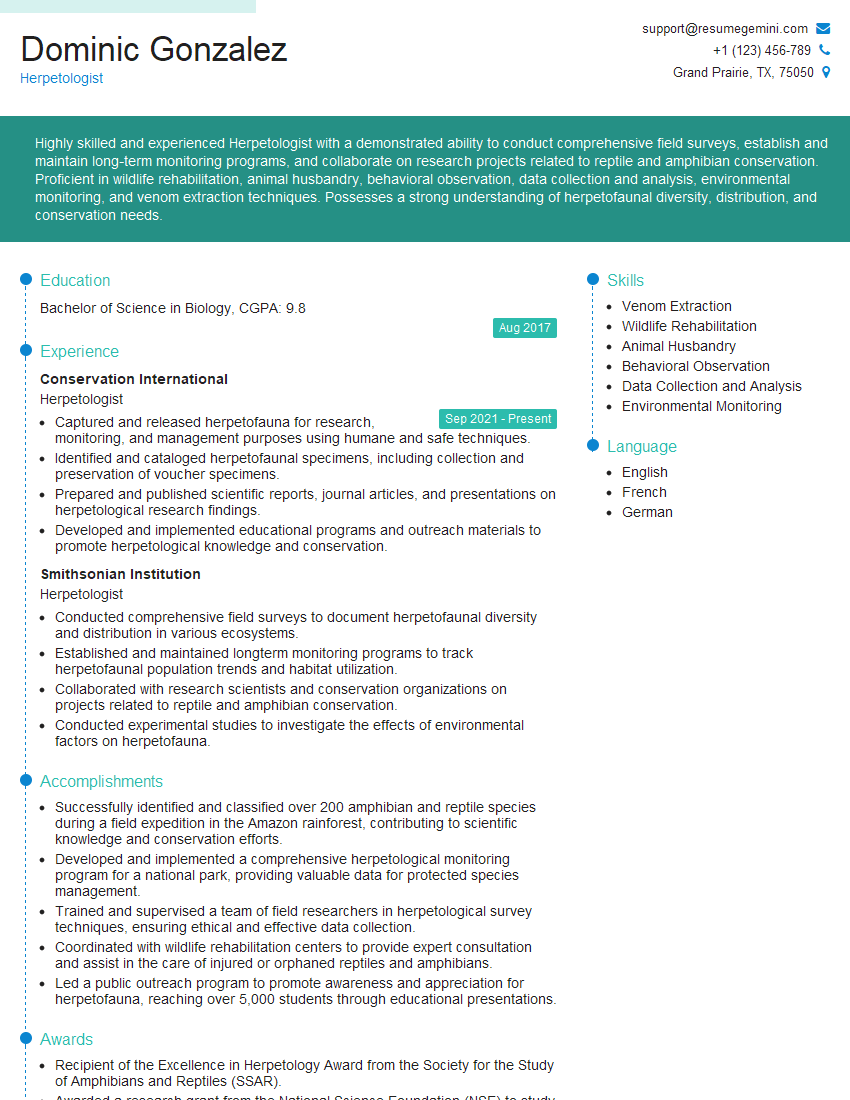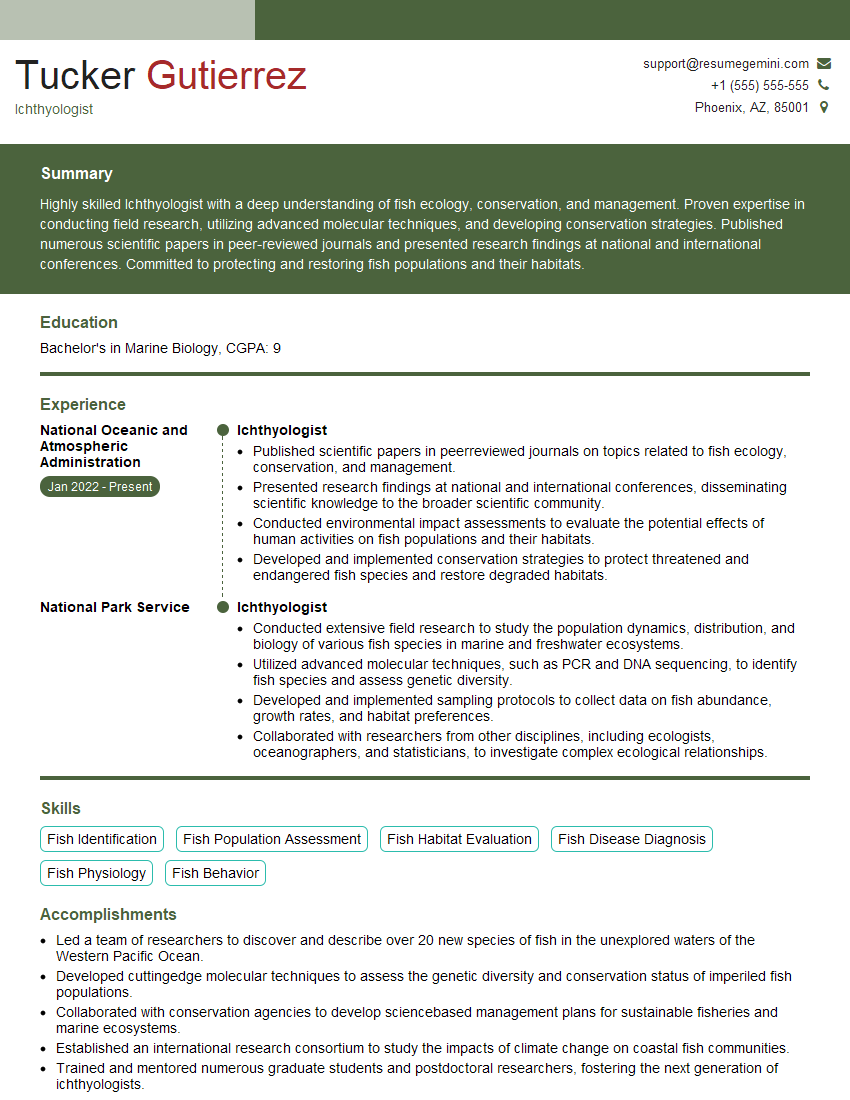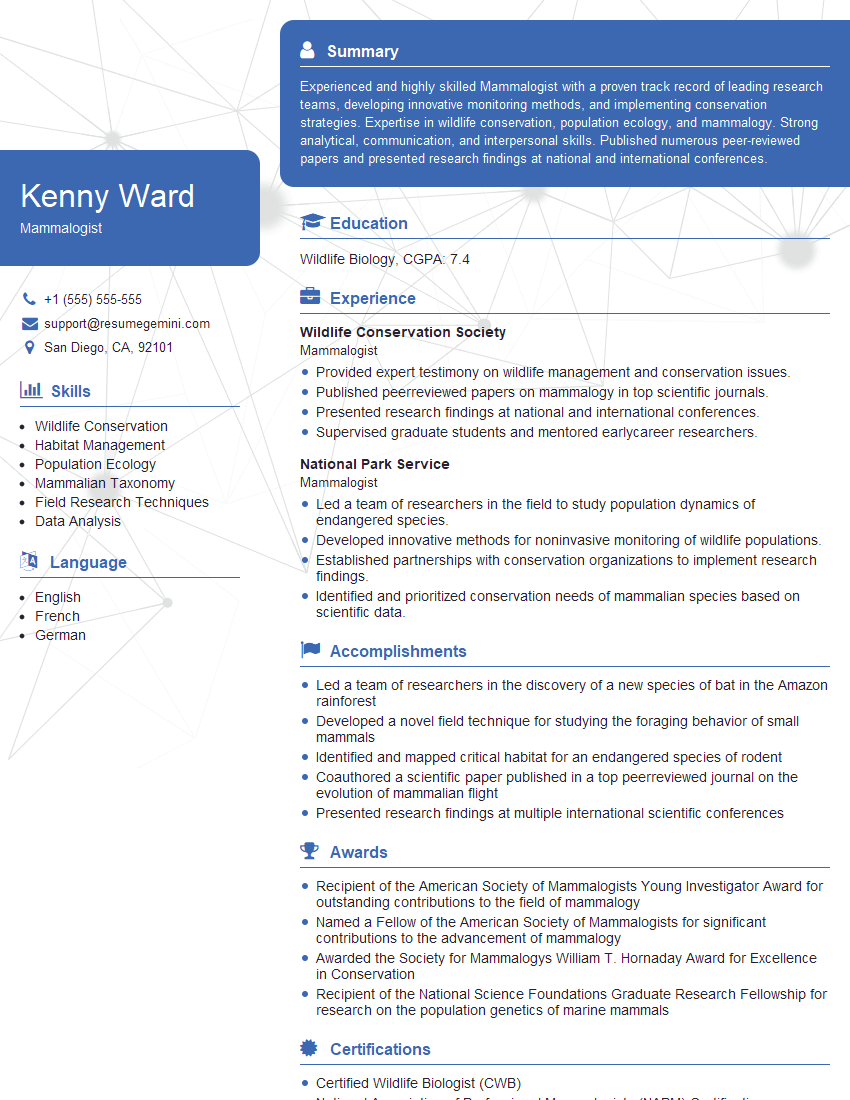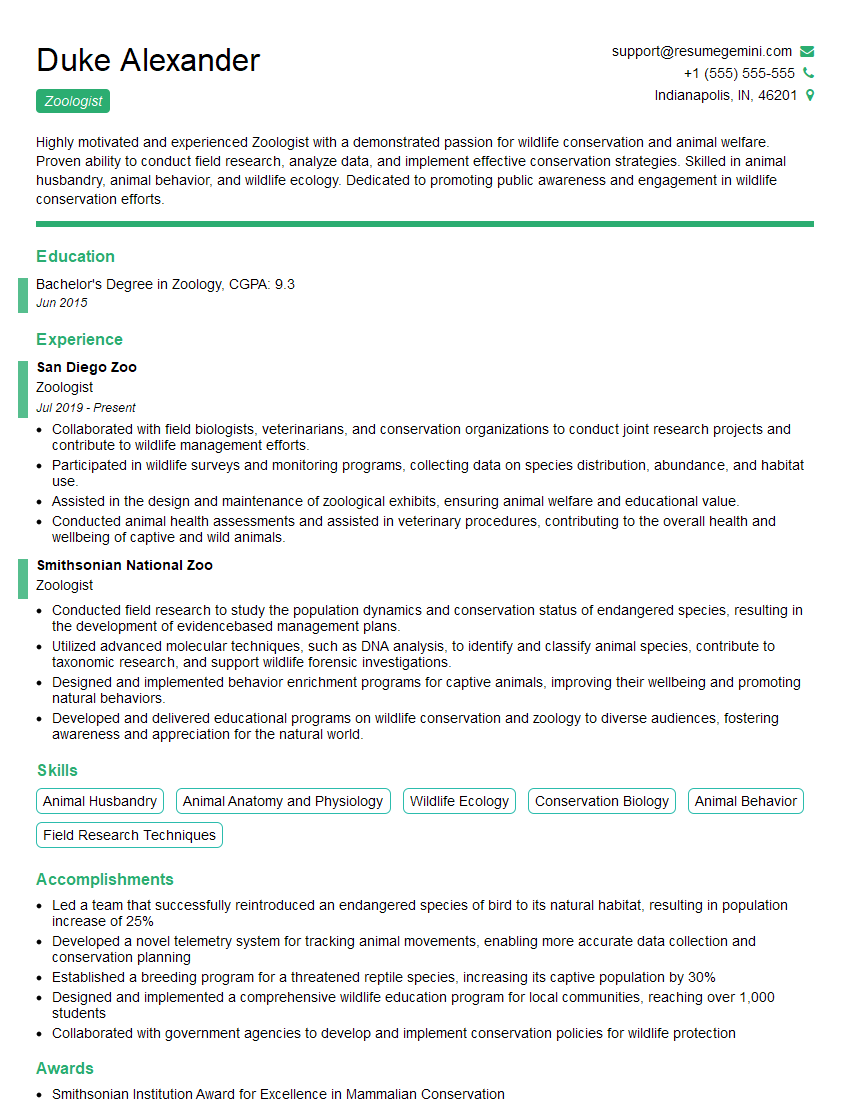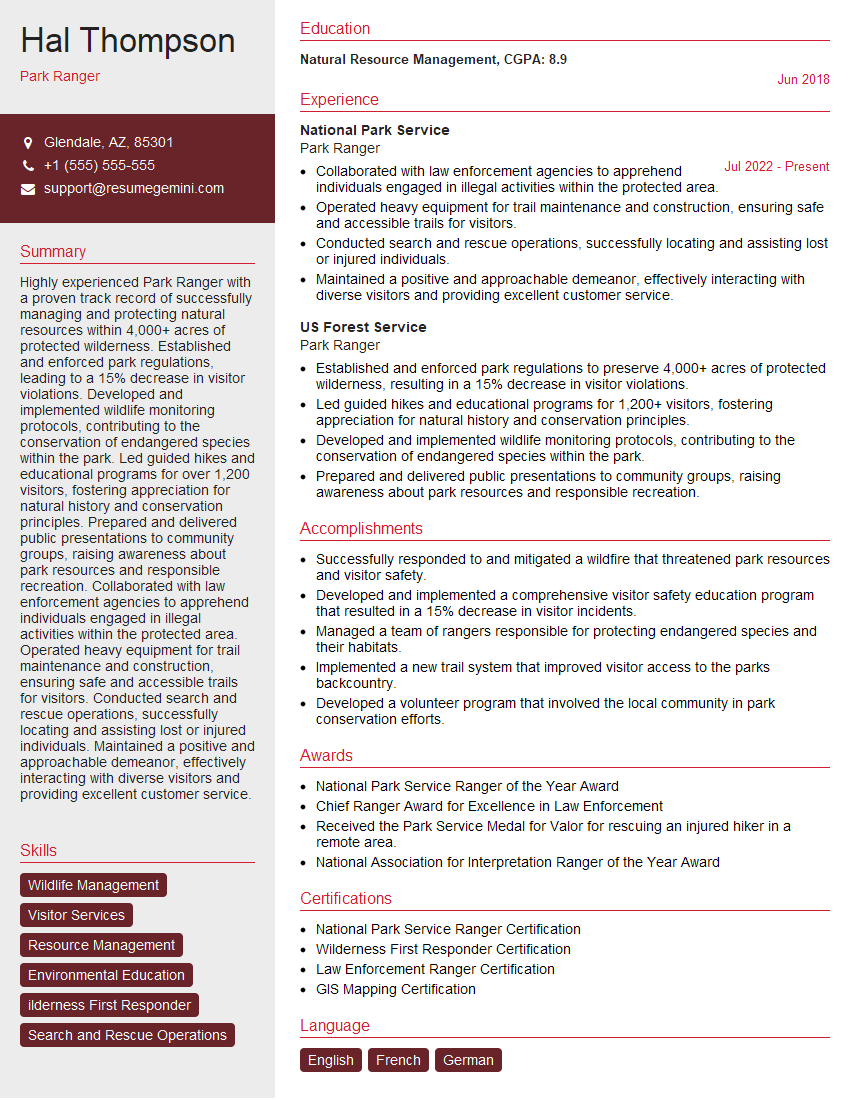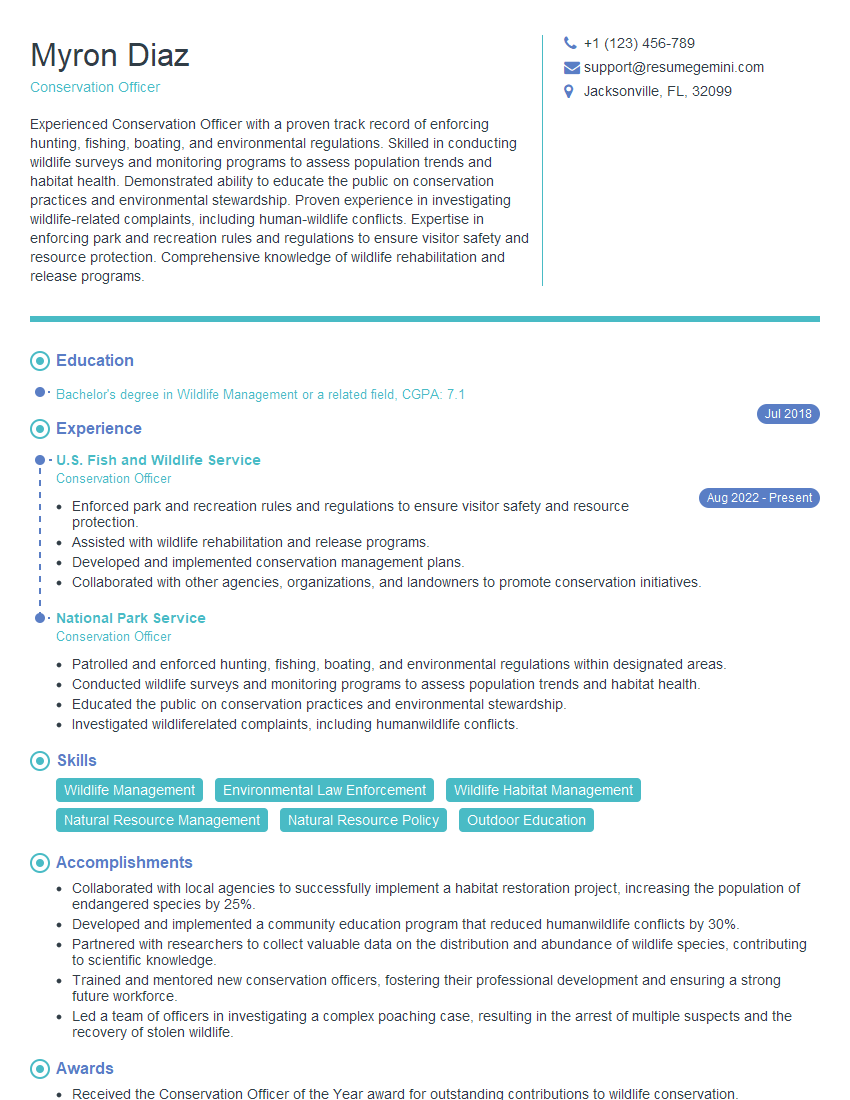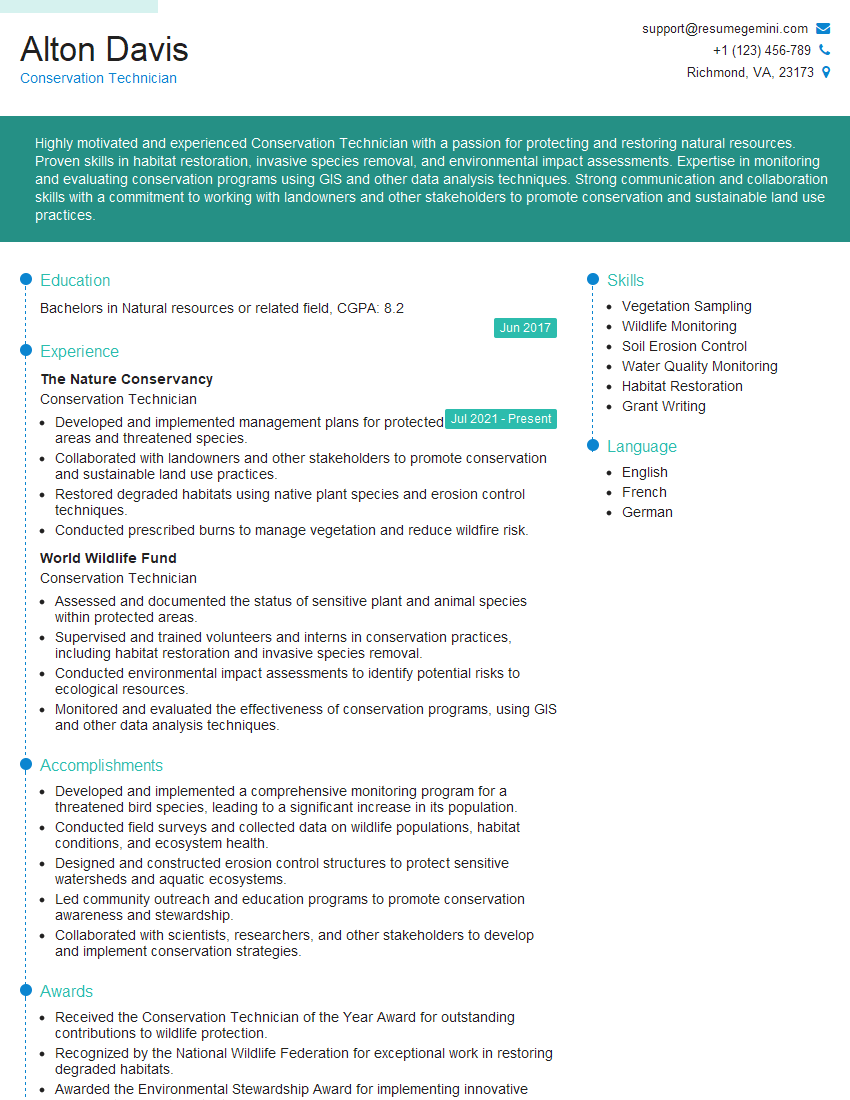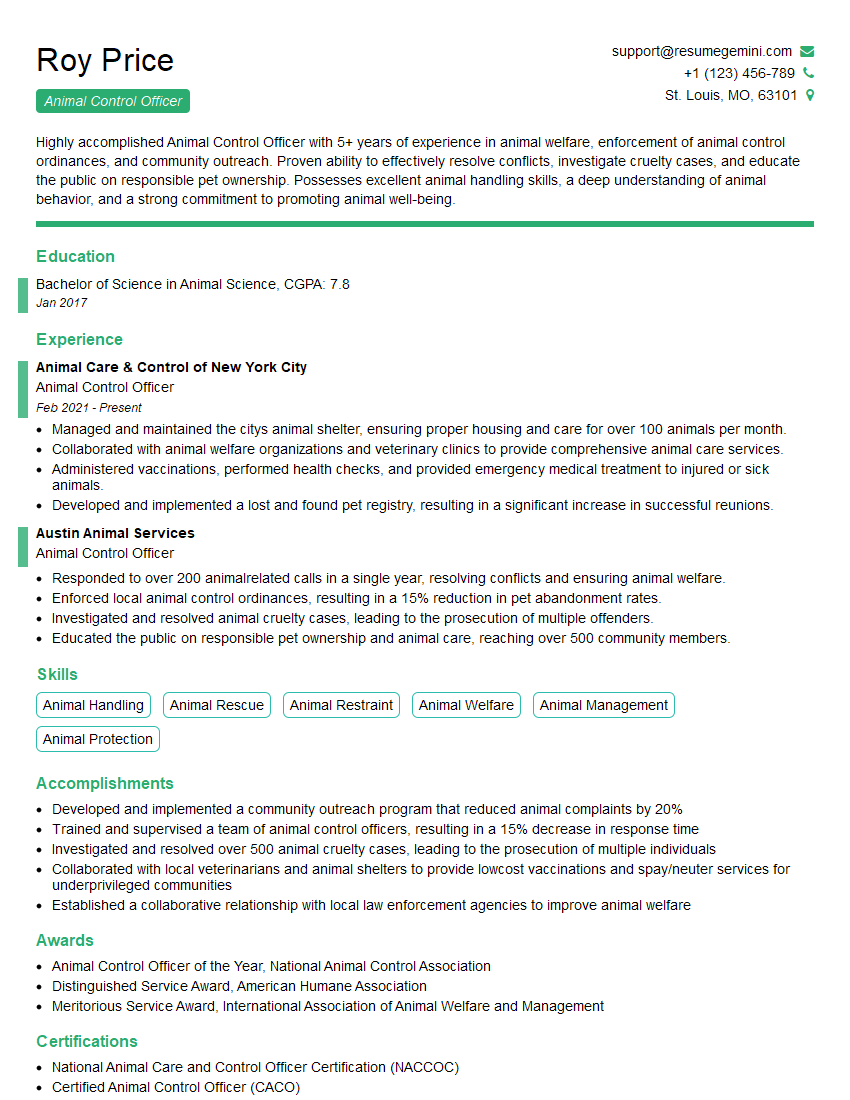Unlock your full potential by mastering the most common Safe Capture and Release Methods interview questions. This blog offers a deep dive into the critical topics, ensuring you’re not only prepared to answer but to excel. With these insights, you’ll approach your interview with clarity and confidence.
Questions Asked in Safe Capture and Release Methods Interview
Q 1. Describe the different types of nets used for safe capture and release.
The type of net used for safe capture and release depends heavily on the target species and the environment. We need nets that are strong enough to safely secure the animal but gentle enough to avoid injury. Here are a few examples:
- Mist nets: These are very fine mesh nets, often used for birds. They’re virtually invisible to the birds, minimizing stress and allowing for gentle entanglement.
- Dip nets: These are commonly used for aquatic animals like fish or amphibians. They allow for quick and efficient capture, reducing handling time.
- Throw nets: Larger nets that are thrown over an area to capture multiple animals. While effective, it requires skill and precision to prevent injuries.
- Trapping nets: These are often used in conjunction with bait or lures and are designed to enclose the animal within a designated area. These require careful consideration of the animal’s behavior and needs to minimize stress.
Choosing the right net involves careful consideration of the target species’ size, behavior, and the environment in which the capture will take place. For instance, a large throw net might be ideal for catching fish in a pond, whereas a smaller dip net would be more appropriate for collecting tadpoles.
Q 2. Explain the importance of minimizing stress during animal capture.
Minimizing stress during animal capture is paramount for ethical and scientific reasons. Stressed animals are more likely to be injured, become ill, or exhibit abnormal behaviors, potentially jeopardizing the success of the research or conservation effort. Physiological stress responses can suppress the immune system, making animals more susceptible to disease. Furthermore, excessive stress can lead to inaccurate data collection in research studies. For example, a stressed animal might exhibit atypical behaviors that misrepresent its normal patterns. Minimizing stress involves using appropriate capture techniques, quick handling, and providing a safe and quiet environment during transport and processing.
Q 3. What are the ethical considerations in using traps for wildlife capture?
Ethical considerations in using traps for wildlife capture are extensive. We must prioritize minimizing suffering and ensuring the welfare of the animal. Key concerns include:
- Trap design and placement: Traps must be designed to minimize injury and quickly incapacitate the animal to reduce stress. Placement should be strategic, avoiding areas where non-target species are likely to be caught.
- Trap checking frequency: Regular trap checks are crucial to prevent animals from suffering prolonged confinement or injury. This frequency is species-specific and varies depending on environmental factors like temperature.
- Species-specific considerations: Some species are more sensitive to trapping than others. Using appropriate trap types and considering the animal’s physiological tolerance are critical.
- Post-capture care: Careful handling, appropriate anesthesia (if needed), and timely release are all essential aspects of ethical trap use. Any injury sustained during capture should be addressed immediately.
Ethical trap use often requires a thorough understanding of animal behavior and ecology to predict and prevent issues.
Q 4. How do you choose the appropriate anesthetic for a particular species?
Selecting the appropriate anesthetic for a particular species is critical and requires a deep understanding of the animal’s physiology and metabolism. Several factors are considered:
- Species-specific sensitivity: Different species have varying sensitivities to different anesthetic agents. A dose effective for one species could be lethal to another.
- Route of administration: The method of delivering the anesthetic (injection, inhalation, etc.) influences the onset and duration of its effects. Each route comes with specific considerations for safety and effectiveness.
- Animal’s health status: Existing health conditions can influence the choice and dosage of anesthetic. A pre-anesthetic health assessment is often necessary.
- Environmental conditions: Temperature and humidity can affect anesthetic metabolism and efficacy.
Veterinary guidance is crucial in selecting and administering anesthetics to wildlife. This process isn’t something to be attempted without extensive training and expertise.
Q 5. Describe the steps involved in safely handling and releasing a bird.
Safely handling and releasing a bird involves a series of careful steps:
- Gentle capture: If using a net, remove the bird carefully, minimizing entanglement. If possible avoid direct handling.
- Assessment: Quickly check for injuries, noting any signs of stress.
- Data collection (if applicable): Weigh the bird, take measurements, and collect any necessary samples quickly and efficiently.
- Safe transport: Use a suitable container to minimize stress and prevent escape. A well-ventilated container is essential.
- Release: Choose a suitable location for release, ideally near its original capture site and preferably in a sheltered area away from potential predators. Release gently, allowing the bird to fly away naturally.
Throughout the entire process, minimize handling time and avoid unnecessary disturbance. Remember, the goal is to return the bird to its natural environment as quickly and safely as possible.
Q 6. What are the signs of stress in a captured animal?
Recognizing signs of stress in a captured animal is vital for ensuring its welfare. Signs can vary depending on the species, but some common indicators include:
- Increased heart rate and respiration: Rapid breathing and a strong, fast pulse are often indicative of stress.
- Panting or labored breathing: This is particularly notable in animals that don’t normally pant.
- Dilated pupils: Enlarged pupils can be a sign of fear or anxiety.
- Vocalizations: Unusual calls or cries might signify distress.
- Restlessness or agitation: Excessive movement, attempts to escape, or aggressive behavior are indicators of stress.
- Defecation or urination: These involuntary actions often occur during stress.
Recognizing these signs allows for prompt adjustments to handling procedures, ensuring the animal’s well-being.
Q 7. How do you handle a potentially aggressive animal during capture?
Handling a potentially aggressive animal requires caution and appropriate safety measures. The approach depends heavily on the species and the situation:
- Species-specific knowledge: Understanding the animal’s typical behavior and triggers for aggression is crucial.
- Protective equipment: Using appropriate safety gear, such as thick gloves, protective clothing, and in some cases, specialized shields, is essential.
- Minimizing stimuli: Avoid sudden movements or loud noises that could provoke aggression.
- Controlled environment: If possible, conduct the capture in a controlled environment that limits the animal’s escape routes.
- Chemical immobilization (if necessary and appropriate): In some cases, using chemical immobilization may be necessary to safely handle an aggressive animal. This must be done only by trained personnel following appropriate protocols.
Always prioritize safety for both the animal and the handler. In cases of severe aggression or uncertainty, seek assistance from trained professionals.
Q 8. What safety precautions should be taken when capturing and releasing venomous snakes?
Handling venomous snakes demands extreme caution. The primary safety precaution is prevention – avoiding unnecessary contact. If capture is unavoidable, specialized equipment is crucial. This includes sturdy snake tongs long enough to maintain a safe distance, heavy-duty gloves made of puncture-resistant material (such as Kevlar), and appropriate eye protection.
Always approach a venomous snake slowly and calmly, observing its behavior before attempting any action. Never try to grab a snake by hand. The chosen capture method depends on the species and the situation, but generally involves using tongs to gently grasp the snake behind the head, keeping a firm but not overly tight grip. After capture, secure the snake in a safe, well-ventilated container to prevent escape and minimize stress.
Crucially, after release, thoroughly decontaminate all equipment to eliminate any venom residue.
Q 9. Explain the importance of proper data recording during capture and release events.
Meticulous data recording is fundamental for scientific validity and conservation efforts. The data collected allows researchers to understand snake populations, their distribution, behavior, and health. This contributes to evidence-based conservation strategies and helps track population changes over time.
- Species Identification: Precise species identification using morphological characteristics and/or genetic analysis is vital.
- Location Data: Accurate GPS coordinates are essential to map the animal’s location and contribute to habitat mapping.
- Morphological Measurements: Accurate measurements of length, weight, and other relevant characteristics provide insights into individual health and population demographics.
- Health Assessment: A detailed record of the snake’s overall health, including any signs of injury, disease, or parasites, is recorded.
- Behavioral Observations: Observations of the snake’s behavior (e.g., activity level, defensive postures) during capture and release provide valuable data.
- Environmental Conditions: Recording weather conditions, habitat type, and other environmental factors at the capture site is critical for understanding the animal’s ecological context.
Data is often entered into a database for analysis, allowing for longitudinal studies and comparisons across various populations.
Q 10. Describe your experience with different types of immobilization techniques.
My experience encompasses various immobilization techniques, each appropriate for different scenarios and species. For non-venomous snakes, I’ve utilized gentle restraint techniques, holding the snake firmly but without causing undue stress. This often involves supporting the body and manipulating the snake into a secure position.
For venomous snakes, I exclusively rely on snake tongs to maintain a safe distance. Chemical immobilization is only used in specialized research projects where it’s absolutely necessary and under the supervision of a qualified veterinarian. This usually involves using an anesthetic agent appropriately and carefully administered by a qualified professional.
Over-immobilization should be avoided at all times as this could cause injury to the animal.
Q 11. How do you ensure the safety of both the animal and the handler during capture?
Ensuring the safety of both the animal and handler relies on a combination of factors. Preparation is key. Selecting the right equipment (e.g., appropriate snake tongs, protective gear), understanding the animal’s behavior, and having a well-defined capture and release plan are all critical.
During the capture itself, smooth, controlled movements minimize stress to the animal. The technique used should minimize injury risk to both the animal and the handler. Following capture, the animal should be handled as gently as possible, kept in a secure container appropriate for its size, and released back to its habitat promptly. After release, careful observation is important, to ensure that the animal is able to move away safely.
I always work with a partner for added safety and to ensure a smooth and efficient process.
Q 12. What are the potential risks associated with improper handling techniques?
Improper handling techniques can lead to a range of negative consequences for both the handler and the animal. For the handler, these risks include:
- Venomous Bites: Incorrect handling of venomous snakes can result in painful and potentially life-threatening bites.
- Injuries from Scratching or Biting: Even non-venomous snakes can cause significant injury through scratching or biting.
- Stress and Anxiety: The stress of the encounter can impact the handler’s physical and mental well-being.
For the animal, improper handling can lead to:
- Physical Injuries: Rough handling, improper restraint, or dropping the snake can cause physical trauma.
- Stress and Exhaustion: Stress from improper handling can compromise the animal’s health and survival.
- Increased Risk of Mortality: Injuries and stress caused by improper handling can significantly increase the animal’s risk of death.
Furthermore, improper release techniques can lead to the animal being disoriented or unable to successfully return to its habitat.
Q 13. How do you assess the health of a captured animal?
Assessing a captured animal’s health involves a visual examination and, if necessary, more detailed assessment. The visual examination looks for signs of injury, such as wounds, parasites, or deformities. I assess the animal’s body condition, looking for signs of emaciation or dehydration. The snake’s alertness, responsiveness, and overall activity level are also considered.
Depending on the situation, further assessment might involve measuring vital signs like body temperature, if appropriate equipment is available. In cases of suspected illness or injury, veterinary intervention might be required. It is important to minimize the handling time to reduce the stress on the animal.
Q 14. Describe your experience with radio telemetry and its use in capture and release studies.
Radio telemetry has been invaluable in my capture and release studies, providing real-time data on the movements and behavior of animals after release. I’ve used it extensively to track snake movements in their natural environment, studying their home range, habitat use, and responses to environmental changes.
The process involves implanting a small radio transmitter (carefully and with proper veterinary oversight) into the animal, which emits a signal that can be detected by a receiver. By tracking the signal, we can monitor the animal’s location over time, gaining insights into its daily activities and long-term movements.
This technology allows for a much deeper understanding of the animal’s ecology and behavior, which is crucial for developing effective conservation strategies.
Q 15. How do you choose the appropriate release site for an animal?
Selecting the appropriate release site is crucial for the animal’s survival and successful reintegration into its habitat. It’s not just about dropping the animal off somewhere; it’s about finding a location that closely mirrors its original environment and minimizes risks.
- Habitat Suitability: The site must provide adequate food, water, shelter, and suitable cover. We assess factors like vegetation type, prey availability (if a predator), presence of natural predators, and overall habitat quality. For example, releasing a forest-dwelling bird in an open field would be disastrous.
- Distance from Capture Site: Ideally, the release site should be a reasonable distance from the capture location to reduce the likelihood of the animal returning to the original problematic area. The distance will vary depending on the species and its home range.
- Safety Considerations: We carefully evaluate potential threats at the release site, such as human activity, traffic, domestic animals, or other dangers. We might need to choose a site with limited human access or implement measures to reduce these risks.
- Disease Prevalence: The prevalence of diseases in the release area should be considered to minimize exposure for the released animal. If there’s a known disease outbreak, we’d look for a healthier habitat.
- Connectivity to Existing Population: For endangered species, it’s important to release the animal in an area where it can potentially interact with its conspecifics (animals of the same species) to facilitate breeding and gene flow.
The decision-making process often involves consulting maps, satellite imagery, field surveys, and expert knowledge of the species’ ecology and behavior. We may also utilize GPS tracking data from previous releases to inform the choice of a suitable site.
Career Expert Tips:
- Ace those interviews! Prepare effectively by reviewing the Top 50 Most Common Interview Questions on ResumeGemini.
- Navigate your job search with confidence! Explore a wide range of Career Tips on ResumeGemini. Learn about common challenges and recommendations to overcome them.
- Craft the perfect resume! Master the Art of Resume Writing with ResumeGemini’s guide. Showcase your unique qualifications and achievements effectively.
- Don’t miss out on holiday savings! Build your dream resume with ResumeGemini’s ATS optimized templates.
Q 16. Explain the importance of post-release monitoring.
Post-release monitoring is absolutely vital for assessing the success of the capture and release operation and informing future efforts. It helps us understand if the animal is adapting to its new environment and surviving. Think of it like this: you wouldn’t perform surgery and then never check on the patient!
- Survival Rate: Monitoring allows us to determine the survival rate of released animals over time, identifying potential threats and areas for improvement in our procedures. We often use GPS trackers or visual observations for this.
- Habitat Use: Monitoring helps determine if the animal is using the release site as expected. Is it foraging in suitable areas? Is it finding shelter? This tells us if we made a good site selection.
- Behavior Observation: We observe the animal’s behavior to determine if it’s displaying normal patterns. Signs of stress, illness, or abnormal social interactions can alert us to problems.
- Breeding Success (if applicable): For breeding animals, post-release monitoring is essential to assess reproductive success and the overall contribution to the population.
- Refinement of Techniques: The data collected through post-release monitoring helps us refine our capture and release techniques, improving future outcomes. We might discover new challenges or identify ways to make the process more effective and less stressful for the animals.
The frequency and duration of monitoring will depend on the species, the conservation status, and the research questions being addressed. This could range from short-term visual checks to long-term GPS tracking and population surveys.
Q 17. What are the common challenges encountered during safe capture and release operations?
Safe capture and release operations often present unique challenges. Some common ones include:
- Difficult Capture: Some animals are elusive, quick, or have defensive mechanisms that make capture difficult and potentially dangerous for both the animal and the handlers. This is especially true for nocturnal or cryptic species.
- Stress and Injury: The capture and handling process can be stressful for the animal, potentially leading to injury, illness, or even death. Minimizing stress is a paramount concern.
- Adverse Weather Conditions: Unexpected changes in weather can significantly impact the safety and efficiency of operations. For example, extreme heat or heavy rain can be dangerous.
- Difficult Terrain: Accessing the capture and release sites can be challenging, particularly in rugged or remote areas. This might necessitate specialized equipment or techniques.
- Lack of Resources: Adequate funding, equipment, and trained personnel are essential for safe and effective capture and release operations. A lack of any of these can greatly hinder efforts.
- Unexpected Animal Behavior: Animals can sometimes behave unpredictably, posing challenges for capture and handling.
Overcoming these challenges requires careful planning, appropriate equipment, a skilled team, and a thorough understanding of animal behavior and ecology. Contingency planning is crucial to manage unexpected situations effectively.
Q 18. How do you adapt your techniques to different animal species and environments?
Adaptability is key to successful capture and release. Our techniques must be tailored to the specific species and environment. We cannot use the same approach for a small bird as we would for a large mammal.
- Species-Specific Considerations: Different species have unique physiological and behavioral characteristics that influence capture and handling methods. For example, a reptile’s handling differs significantly from that of a bird or mammal. Some may require specialized restraint techniques to avoid injury.
- Environmental Adaptations: The environment significantly influences our approach. A capture method effective in an open field might be unsuitable in dense forest. Terrain, vegetation, and weather dictate our choices.
- Equipment Selection: We choose equipment appropriate to the animal and environment. Nets, traps, dart guns, and even specialized handling devices are selected based on the species and situation. Safety and minimal animal stress are always our priority.
- Training and Expertise: The team’s expertise and training are vital. We need individuals trained in handling different species and navigating various environments. Continuing education and experience are critical.
For instance, capturing a swift-moving gazelle requires different techniques and equipment than capturing a slow-moving tortoise. Similarly, operating in a dense jungle requires different approaches than operating in a grassland.
Q 19. Describe your experience with working with endangered or threatened species.
Working with endangered or threatened species requires an exceptionally cautious and meticulous approach. The stakes are incredibly high; every action must be carefully considered to avoid jeopardizing the survival of these animals.
- Minimizing Stress: We prioritize minimizing stress to avoid weakening the animal and compromising its chances of survival. Every step, from capture to release, is designed to reduce stress.
- Specialized Training: Handling endangered species often requires specialized training and certifications, and adherence to strict protocols.
- Thorough Planning: We invest significant time in planning and conducting thorough risk assessments before attempting any capture or release operation. This includes considering potential impacts on the animal’s health and the overall population.
- Collaboration and Permits: Working with endangered species typically involves collaboration with multiple stakeholders, including government agencies, research institutions, and conservation organizations. We need all the necessary permits and approvals before proceeding.
- Genetic Sampling (where appropriate): In some cases, we collect genetic samples to aid in monitoring the population and assess the species’ genetic diversity.
I have personally participated in several projects involving endangered primates, where careful planning and execution of capture and release methods were critical to ensuring the animals’ welfare and the success of the conservation efforts.
Q 20. How do you deal with unexpected situations during a capture and release event?
Unexpected situations are a reality in wildlife work. Our preparedness and response depend heavily on the situation.
- Assessment: The first step is to rapidly assess the situation to understand the nature of the problem and the potential risks to the animal and the team.
- Safety First: The safety of both the animal and the team is paramount. If a situation becomes unsafe, we immediately prioritize the safety of everyone involved, possibly by temporarily suspending operations.
- Problem-Solving: We rely on our training, experience, and teamwork to develop effective solutions. This might involve improvising with available resources, calling for assistance, or changing our approach entirely.
- Communication: Clear and effective communication among the team members is crucial in managing unexpected events. Every team member must be aware of the situation and their role in addressing it.
- Documentation: All unexpected events and our responses are meticulously documented to learn from the experience and improve future operations.
For example, if an animal unexpectedly becomes aggressive during capture, we might need to employ different restraint techniques or call for additional help. If the weather deteriorates unexpectedly, we might need to temporarily suspend operations or find alternative shelter.
Q 21. What are the legal and regulatory requirements for capturing and releasing wildlife in your area?
The legal and regulatory requirements for capturing and releasing wildlife vary significantly depending on location. In my area [replace with your area/region], the regulations are stringent and aim to protect wildlife populations and prevent harm. These typically include:
- Permits and Licenses: Capture and release operations almost always require specific permits or licenses from relevant government agencies. These permits are granted only after thorough review of the proposed project and its potential impact on wildlife.
- Species-Specific Regulations: Certain species might have specific regulations regarding handling, transportation, and release methods. Endangered or threatened species will have stricter regulations and require even more rigorous permits.
- Ethical Guidelines: Capture and release activities must adhere to strict ethical guidelines to minimize stress and injury to animals and ensure that the operations do not harm the surrounding ecosystem. Many organizations have their own internal guidelines.
- Reporting Requirements: We are usually required to submit detailed reports documenting the capture, handling, and release processes. This reporting includes information on the animals’ condition, the methods employed, and the location of the release.
- Data Management and Sharing: The data collected during the operation must be appropriately managed and may need to be shared with government agencies or other relevant organizations.
Ignorance of these regulations can result in serious penalties, including fines, suspension of permits, or even legal prosecution. Strict adherence to the regulations is essential for the ethical and legal conduct of capture and release operations.
Q 22. Describe a time when you had to improvise during a capture and release operation.
Improvisation is sometimes crucial in capture and release, especially when dealing with unexpected animal behavior or equipment malfunctions. For instance, during a bird banding operation, a strong gust of wind unexpectedly blew away the mist net I was using, scattering the birds. Instead of panicking, I quickly assessed the situation. We had a smaller, hand-held net and utilized a nearby thicket for cover, allowing us to gradually and quietly recapture the birds. This involved adapting our strategy from a large-scale capture to a more precise, individual approach, prioritizing the birds’ safety and minimizing stress. The key was remaining calm, reassessing the immediate conditions, and finding alternative tools and methods to ensure a successful operation.
Q 23. How do you ensure the long-term survival of animals after release?
Ensuring long-term survival after release requires a multifaceted approach. It begins with pre-release health checks: assessing the animal’s physical condition, ensuring it’s free from parasites or injury, and providing any necessary veterinary care. The release site is equally critical; we meticulously select a location that mimics the animal’s natural habitat, offering sufficient food, water, and shelter. Post-release monitoring, often involving tracking devices, is invaluable for assessing the animal’s adaptation and survival rate. For example, fitting a radio collar to a relocated wolf allows us to monitor its movement and identify potential challenges. We also consider habitat restoration and mitigation of human-wildlife conflict – this means working with local communities to educate them about responsible coexistence and minimizing threats to the animal’s survival.
Q 24. What are the key factors to consider when selecting capture equipment?
Selecting capture equipment involves careful consideration of several factors. The target species’ size, behavior, and habitat are paramount. For instance, a small rodent would require a different trap than a large mammal. The equipment’s safety for both the animal and the handler is essential – it should minimize stress and injury. Ease of use and maintainability are also vital. Finally, the equipment must be appropriate for the specific capture method – a mist net for birds, a Sherman trap for small mammals, or a dart gun for larger, more dangerous animals. Always prioritize equipment that adheres to ethical guidelines and minimizes harm to the animal.
Q 25. Explain your understanding of the principles of minimal-impact capture techniques.
Minimal-impact capture techniques prioritize minimizing stress, injury, and disturbance to the animal. This involves using appropriate equipment, careful handling, and quick processing. For example, using a soft-release trap rather than a snare minimizes the risk of injury. We strive for quick processing times – the animal should only be handled for as long as absolutely necessary for data collection and any needed medical interventions. Pre-capture planning, such as scouting the location and understanding animal behavior, allows for a smoother capture process. Post-release monitoring helps evaluate the effectiveness of the technique and identify areas for improvement. The overarching principle is to treat each animal with respect and minimize the potential negative impact of human intervention.
Q 26. How do you maintain accurate records and comply with data management protocols?
Accurate record-keeping is the cornerstone of responsible wildlife management. We use a combination of methods, including standardized data sheets, digital databases, and GPS tracking. Data includes details about the capture site, animal’s species, measurements, health assessment, and any treatments administered. All data are entered using a consistent format, ensuring accuracy and facilitating analysis. We comply with relevant regulations and ethical guidelines, adhering to data management protocols specific to the project and governing agencies. Data security is also prioritized, limiting access and using appropriate safeguards to protect sensitive information. For instance, all data is backed up to a cloud server and encrypted for added security.
Q 27. Describe your proficiency in using various data logging devices and software.
My experience encompasses a range of data logging devices and software. I am proficient with GPS collars, data loggers for environmental conditions (temperature, humidity), and various handheld devices for recording biometric data. Software expertise includes database management systems such as Access and programs like ArcGIS for spatial data analysis. I am also familiar with specialized software for analyzing animal movement data, allowing for the creation of detailed maps and visualizations of animal activity and habitat utilization. The key is understanding not only how to use these tools but also how to interpret the resulting data to inform conservation strategies and management decisions.
Q 28. What steps do you take to ensure the safety of human handlers and the public during a capture and release operation?
Safety is paramount in capture and release operations. For human handlers, this involves using appropriate personal protective equipment (PPE), such as gloves, safety glasses, and protective clothing, depending on the species involved. Teamwork and clear communication are essential. We always work in teams, utilizing predetermined protocols and emergency response plans. For the public, this involves clearly defined safety zones and public awareness campaigns. Signage, communication with landowners, and sometimes temporary closures of public access are employed. Risk assessments are conducted before each operation, identifying potential hazards and establishing mitigation strategies. The goal is to conduct the operation safely and efficiently, ensuring the safety and well-being of both the animals and the human team.
Key Topics to Learn for Safe Capture and Release Methods Interview
- Animal Behavior and Handling: Understanding species-specific behaviors crucial for safe and effective capture and minimizing stress.
- Capture Techniques: Mastering various trapping methods (e.g., nets, traps, snares) and their appropriate application based on the target species and environment.
- Equipment Selection and Use: Safe and proficient use of specialized equipment, including proper maintenance and safety procedures.
- Data Collection and Recording: Accurate documentation of capture events, including species identification, measurements, health assessments, and location data.
- Release Procedures: Implementing safe and effective release strategies to ensure animal well-being and minimize post-release mortality.
- Health and Safety Protocols: Prioritizing personal safety and minimizing risks associated with handling potentially dangerous animals.
- Ethical Considerations: Understanding and adhering to ethical guidelines related to wildlife capture and handling, including minimizing disturbance and ensuring animal welfare.
- Risk Assessment and Mitigation: Identifying potential hazards and implementing appropriate measures to prevent accidents and injuries.
- Regulatory Compliance: Adherence to relevant permits, regulations, and best practices related to wildlife capture and release.
- Problem-Solving and Decision-Making: Analyzing situations, adapting strategies, and making informed decisions in diverse field settings.
Next Steps
Mastering Safe Capture and Release Methods is paramount for career advancement in wildlife management, conservation, and related fields. Demonstrating proficiency in these techniques significantly enhances your candidacy for positions requiring hands-on experience and a commitment to animal welfare. To improve your job prospects, it’s crucial to create a compelling and ATS-friendly resume that highlights your skills and experience. We strongly recommend using ResumeGemini to build a professional resume tailored to the specific requirements of Safe Capture and Release Methods roles. ResumeGemini offers valuable tools and resources to ensure your resume effectively showcases your qualifications. Examples of resumes tailored to Safe Capture and Release Methods positions are available to help guide you through the process.
Explore more articles
Users Rating of Our Blogs
Share Your Experience
We value your feedback! Please rate our content and share your thoughts (optional).
What Readers Say About Our Blog
Hello,
We found issues with your domain’s email setup that may be sending your messages to spam or blocking them completely. InboxShield Mini shows you how to fix it in minutes — no tech skills required.
Scan your domain now for details: https://inboxshield-mini.com/
— Adam @ InboxShield Mini
Reply STOP to unsubscribe
Hi, are you owner of interviewgemini.com? What if I told you I could help you find extra time in your schedule, reconnect with leads you didn’t even realize you missed, and bring in more “I want to work with you” conversations, without increasing your ad spend or hiring a full-time employee?
All with a flexible, budget-friendly service that could easily pay for itself. Sounds good?
Would it be nice to jump on a quick 10-minute call so I can show you exactly how we make this work?
Best,
Hapei
Marketing Director
Hey, I know you’re the owner of interviewgemini.com. I’ll be quick.
Fundraising for your business is tough and time-consuming. We make it easier by guaranteeing two private investor meetings each month, for six months. No demos, no pitch events – just direct introductions to active investors matched to your startup.
If youR17;re raising, this could help you build real momentum. Want me to send more info?
Hi, I represent an SEO company that specialises in getting you AI citations and higher rankings on Google. I’d like to offer you a 100% free SEO audit for your website. Would you be interested?
Hi, I represent an SEO company that specialises in getting you AI citations and higher rankings on Google. I’d like to offer you a 100% free SEO audit for your website. Would you be interested?
good


